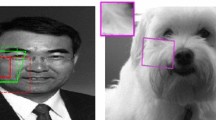Abstract
In morphological image processing and analysis, a template or structuringelement is applied to an image. Often savings in computation time and abetter fit to the given computer architecture can be achieved by using thetechnique of template decomposition. Researchers have written a multitude ofpapers on finding such decompositions for special classes of templates.Justifying recent integer programming approaches to the morphologicaltemplate decomposition problem in its general form, this paper proves theNP-completeness of this problem.
Similar content being viewed by others
References
J.L. Davidson, “Nonlinear matrix decompositions and an application to parallel processing,” Journal of Mathematical Imaging and Vision, vol. 1, no.2, pp. 28–36, 1992a.
J.L. Davidson, “Nonlinear matrix decompositions and an application to parallel processing,” Journal of Mathematical Imaging and Vision, vol. 1, pp. 169–192, 1992b.
J.L. Davidson, “Classification of lattice transformations in image processing,” Computer Vision, Graphics, and Image Processing: Image Understanding, vol. 57, no.3, pp. 283–306, May 1993.
P.D. Gader, “Necessary and sufficient conditions for the existence of local matrix decompositions,” SIAM Journal on Matrix Analysis and Applications, pp. 305–313, July 1988.
P.D. Gader, “Separable decompositions and approximations for gray-scale morphological templates,” CGVIP, vol. 53, pp. 288–296, July 1991.
P.D. Gader and E.G. Dunn, “Image Algebra and Morphological Template Decomposition,” in Aerospace Pattern Recognition, Proceedings of SPIE, Orlando, FL, March 1989, vol. 1098, pp. 134–145.
P.D. Gader and S. Takriti, “Local decomposition of gray-scale morphological templates,” Journal of Mathematical Imaging and Vision, vol. 2, pp. 39–50, 1992.
M.R. Gader and D.S. Johnson, Computers and Interactibility: A Guide to the Theory of NP-Completeness. W.H. Freeman and Company: New York, 1979.
H.J.A.M. Heijmans, “Mathematical morphology: A modern approach in image processing based on algebra and geometry,” SIAM Review, vol. 37, no.1, pp. 1–36, 1995.
S.-Y. Lee and J.K. Aggarwal, “Parallel 2-D convolution on a mesh connected array processor,” IEEE Transactions on Pattern Analysis and Machine Intelligence, vol.PAMI-9, no.4, pp. 590–594, July 1987.
D. Li and G.X. Ritter, “Decomposition of Separable and Symmetric Convex Templates,” in Image Algebra and Morphological Image Processing, Proceedings of SPIE, San Diego, CA, July 1990, vol. 1350. pp. 408–418.
Z.Z. Manseur and D.C Wilson, “Decomposition methods for convolution operators,” Computer Vision, Graphics, and Image Processing, vol. 53, no.5, pp. 428–343, 1991.
G. Matheron, Random Sets and Integral Geometry, Wiley: New York, 1975.
H. Park and R.T. Chin, “Optimal decomposition of convex morphological structuring elements for 4-connected parallel array processors,” IEEE Trans. on Pattern Anal. and Mach. Intell., vol. 16, no.3, pp. 304–313, 1994.
H. Park and R.T. Chin, “Decomposition of arbitrarily shaped structuring elements,” IEEE Pattern Analysis and Machine Intelligence, vol. 17, no.1, pp. 2–15, 1995.
G.X. Ritter, “Recent developments in image algebra,” in P. Hawkes (Ed.), Advances in Electronics and Electron Physics, Academic Press: New York, NY, vol. 80, pp. 243–308, 1991.
G.X. Ritter, J.N. Wilson, and J.L. Davidson, “Image algebra: An overview,” Computer Vision, Graphics, and Image Processing, vol. 49, no.3, pp. 297–331, March 1990.
J. Serra,Image Analysis and Mathematical Morphology. Academic Press: London, 1982.
J. Serra, Image Analysis and Mathematical Morphology, Theoretical Advances, Academic Press: New York, vol. 2, 1988.
P. Sussner, P.M. Pardalos, and G.X. Ritter, “Global optimization problems in computer vision,” in C.A. Floudas and P.M. Pardalos (Eds.), Kluwer Academic Publisher, State of the Art in Global Optimization, pp. 457–474, 1995.
J. Xu, “Decomposition of convex polygonal morphological structuring elements into neighborhood subsets,” IEEE Transactions on Pattern Analysis and Machine Intelligence, vol. 13, no.2, Feb. 1991.
X. Zhuang and R.M. Haralick, “Morphological structuring element decomposition,” Computer Vision, Graphics, and Image Processing, vol. 35, pp. 370–382, 1986.
Author information
Authors and Affiliations
Rights and permissions
About this article
Cite this article
Sussner, P., Pardalos, P. & Ritter, G. On Integer Programming Approaches for Morphological Template Decomposition Problems in Computer Vision. Journal of Combinatorial Optimization 1, 165–178 (1997). https://doi.org/10.1023/A:1009707932516
Issue Date:
DOI: https://doi.org/10.1023/A:1009707932516




